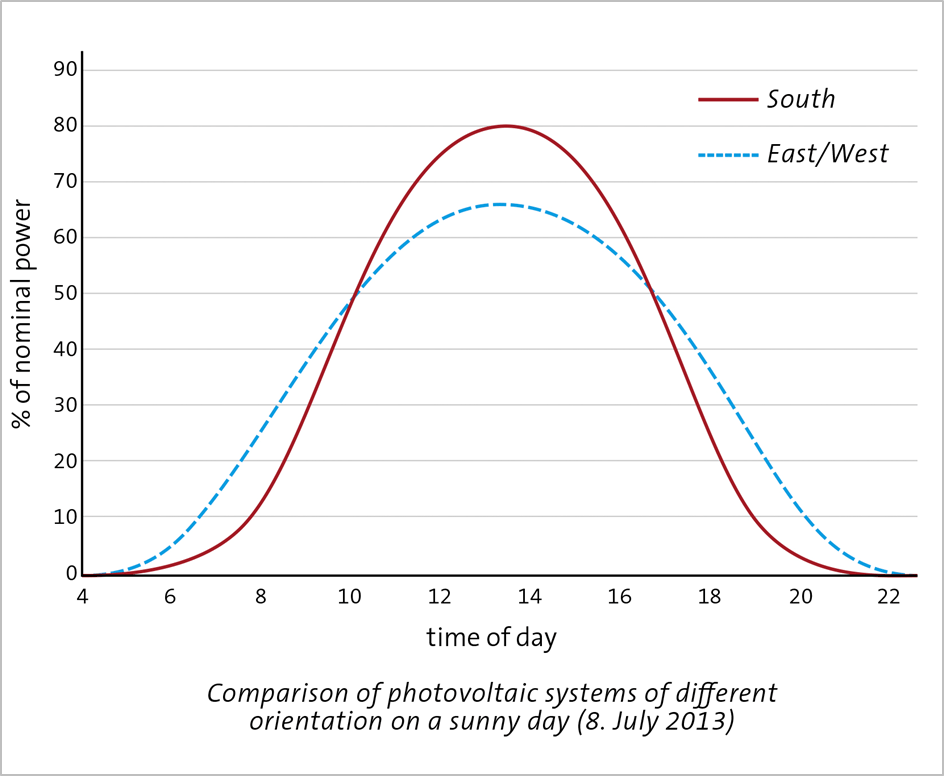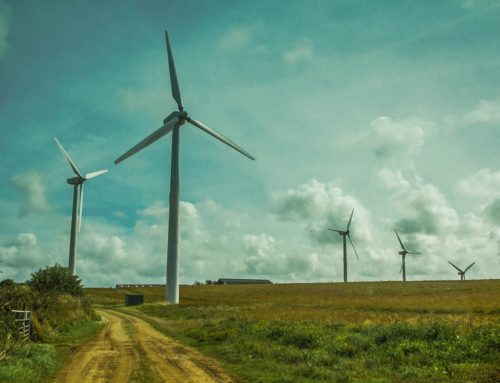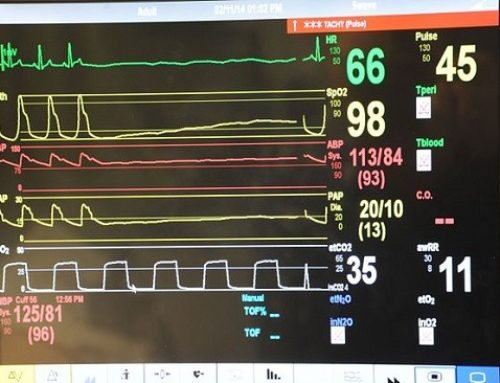by Chloe Bines
8 minute read
I recently attended a ‘build your own solar charger course’ run by Bristol charity Demand Energy Equality at which I constructed a portable 18W solar photovoltaic (PV) panel from second hand solar cells and a laptop case. Having spent a couple of nerve-wracking hours with a soldering iron, the feeling of satisfaction was immense when I finally put my panel out in the sun to charge my phone: success!
Testing my creation, however, I saw first-hand the cruciality of optimal panel positioning. A solar panel generates maximum energy when solar radiation hits it directly – i.e. when the sun’s rays hit the panel perpendicularly. For my little portable system, achieving this was a simple matter of manual adjustment, but for fixed systems it becomes more of a challenge.
A place in the sun
As the sun moves from east to west and up and down in the sky an optimum fixed mounting position must be found if a solar array is to collect the maximum amount of energy possible. Conventionally, fixed systems are set up to be in full direct sunshine in the middle of the day (facing south in the Northern Hemisphere or north in the Southern Hemisphere). This enables the panels to capture solar radiation when it’s strongest and therefore maximise power output.
However, this comes at a sacrifice. Morning and evening sunlight hits the panels at an acute angle, meaning less electricity can be generated at these times of day. Whilst this may not concern homeowners and developers looking to maximise returns on their investments, as national solar PV capacity continues to grow significantly it makes balancing wider supply and demand more challenging.
As more and more south facing systems are installed, the result is a flood of energy in the middle of the day when demand is typically low. Without established smart grids or adequate energy storage currently available, when huge amounts of solar PV output suddenly comes online, in theory other generators must instantly cut back – and ramp up again in microseconds if clouds block the sun. That’s something conventional power stations just aren’t designed to do. As a consequence, the system operator, National Grid, plans half hourly ahead slots for all generation, which is increasingly driven by weather forecasts to take into consideration the volume of solar PV (and wind power) on the system.
This is a growing challenge in the UK and has become a significant problem in Germany, the world leader in terms of installed solar PV capacity. As a result installers and developers are moving towards more east/west facing installations which, instead of maximising power generation from the midday sun, generate electricity at a more consistent level throughout the day.

Throwing curves: different alignments produce different patterns of generation through the day. Source: Renusol
In flat roof applications (which are typically non-household) more panels can actually be installed by opting for an east/west orientation. South-facing solar installations require rows of modules to be spaced further apart to avoid shadows, but as this is not such a problem with east/west installations in which solar modules can therefore be fitted more tightly together on roofs.
For properties with a pitched roof that faces east/west the array can be split so that one side will always benefit from direct sunlight as the sun travels around the building. This set-up requires a duel inverter so that the shaded side does not affect the performance of the panels on the other side.
In both instances the east/west installation will generate power more consistently over the course of the day than a south-facing array. This makes more power available to domestic consumers when they need it: in the morning and evening. It also enables businesses to meet a larger proportion of their energy consumption with solar power produced on their own roofs.

Field generator: an East/West orientation helps solar panels produce electricity more consistently. Photo by Molgreen, via Wikimedia Commons.
Tracking changes
Even better results can be achieved by eschewing fixed mounting and using a ‘tracking’ system to maximise generation throughout the day and across the year. While the results remain dependent on the weather, latitude and amount of uninterrupted horizon, a system that’s always facing the sun can deliver up to 40% more power than a fixed system.
Trackers can be either single or dual-axis. Single-axis trackers account for the daily movement of the sun from east to west, while dual-axis trackers also tilt as the sun rises higher in the sky, thereby continuously keeping the panel(s) perpendicular to the sun.
‘Active’ tracking systems use either hardware (such as photo-sensors) or software which calculates the sun’s path based on latitude, longitude, date and time to steer the tilt and direction of the panel. ‘Passive’ systems utilise a compressed gas liquid contained in linked canisters fixed to the arrays. Liquid on the sunny side of the tracker will heat up and expand, making it lighter than the liquid in the shade and cause the panel to move until balance is restored.
Simpler tracking systems use chronological trackers which counteract the Earth’s rotation by turning at an equal rate in the opposite direction and also employ manual tracking which relies on operators to physically adjust the orientation of the panel.
The gain in electricity output has to be weighed up against the tracker’s capital and set-up costs. There’s also more to go wrong than in a fixed system, so a tracker is likely to attract more repair and maintenance costs. As a result of the technology’s relatively early state of development and, trackers are also likely to have a shorter warranty period than other elements of solar PV systems such as the panels or inverters.
An added complication comes with siting the system to avoid needing to gain planning consent. Roof mounted tracking devices are unlikely to meet UK criteria for permitted development, meaning planning consent is required. A standalone system might meet the criteria, but would take up space that many home and business owners may be reluctant to give up.
Whether tracking makes sense is generally an economic question. The rapid decline in the price of panels means that it is now typically more cost-effective to install a larger fixed array than a smaller array with a tracking system capable of generating the same power. UK solar farm developers are therefore largely continuing to opt for large fixed-mounted arrays that maximise the midday sun.
Put your money where the sun is
As the current subsidy regime in the UK pays generators for any power they produce, it indirectly encourages the installation of south-facing systems to maximise total electricity output and therefore subsidy yield, regardless of the time of day that it is produced. Yet if we are to access the power we need, when we need it, solar power output should be better spread across the day, within a wider network of energy storage and smart grids.
It is possible that imminent subsidy cuts will boost the attractiveness of alternative mounting systems. On 31st March 2015 the Renewables Obligation (RO) will close for solar PV developments over 5MW (albeit with a subsequent ‘grace period’ for some developments). As a result, developers will need to look for other ways to achieve the highest yields from smaller sites and this could generate new interest in tracking systems that can generate a greater power output across the whole day (and year) for the same installed capacity.
Meanwhile, the ever ‘degressing’ Feed-in Tariff (FiT) means that market changes will be needed if solar installations are to continue to generate the investment returns that homeowners and businesses consider sufficiently attractive. So far the rapid decline in the cost of solar panels has broadly kept pace with subsidy cuts, but this cannot continue indefinitely. Consumers may in future be drawn to east/west oriented arrays, which would displace more of their own grid-sourced power and thereby reducing their electricity bills directly rather than being sold onto the grid. However, there can be little assurance that this is the result that the market will actually deliver, especially with plummeting oil and gas (and coal) prices offering the prospect of cheaper electricity.
If we are to see the ‘well-sited and well-designed solar’ that DECC refers to in its Solar PV Strategy then we need to see more joined-up thinking from the Department. Smarter subsidies would reward consistent power generation over a wider time window, and although difficult to design and administer, should be considered in detail by DECC. The alternative is more energy storage, whilst giving areas with a high density of solar generation priority status for the roll out of smart grid solutions. Without such measures, the current incentives will put us in the same boat as Germany with potential negative power prices stifling investment in the sector. With no one to use it and no storage to soak it up, a flood of cheap electricity in the middle of the day risks turning all that glorious sunshine into a waste of energy.






Leave A Comment